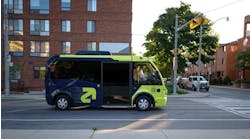New research connects vehicle and infrastructure design for barrier-free mobility
Research has been released by the Autonomous Vehicle Alliance (AVA), the Intelligent Transportation Society of America (ITS America) and AARP, that for the first time looks at barrier-free mobility beyond just the vehicle.
While vehicle accessibility is critical for people with an impairment, so are the immediate surroundings when they enter and exit the vehicle.
“For the first time, vehicle manufacturers and infrastructure creators have an opportunity to work together and create a common design language – one they both could use,” said Tim Woods, general manager, AVA. “We can provide a solution that meets the mobility needs of the majority of transportation users. Autonomy is giving us a chance to do things in a way we never have before.”
“This is another example of the power of transportation technology to transform people’s lives – in this case, for those who don’t have access to traditional mobility modes that so many of us take for granted,” said Shailen Bhatt, president & CEO, ITS America.
An accessible, barrier-free vehicle has been a commonly cited need among municipal, aging and healthcare ecosystems. This research identifies their needs and how people of various abilities could interact with these vehicles and infrastructure. It outlines three opportunities areas to increase mobility options.
Merging the physical world with digital wayfinding tools
If the vehicle and infrastructure are designated as the physical world, the question arises as to how they could seamlessly merge with digital tools, software and an enabling backend. If that happened, it would facilitate more personalized journeys, eliminating the stress of mobility challenges and ensuring a complete trip from point of origin to destination.
Understanding how Universal Design language could impact automated vehicles
Building vehicles and infrastructure that meet the needs of 85 percent of the public is feasible and attainable. Leveraging universal design (UD) would allow shifting the focus to zero entry (no steps required), high head clearance (necessary for wheelchairs and other mobility devices) and interior vehicle features that meet all riders’ needs. If developers use UD language to create digital mobility tools, vehicle management systems could present relevant, real-time information on a more personal level.
Coordinating vehicle design language with infrastructure
Thinking holistically about the entire mobility experience allowed researchers to identify a new opportunity: design language for developing new vehicles should be coordinated with design language for building the infrastructure they interact with. This approach would maximize efficiency and allow riders to seamlessly navigate their journeys, with the potential for the vehicle to create its own infrastructure if needed.
Currently, more than one billion people across the world are living with a disability, and more than 60 percent of people with disabilities report major obstacles as it relates to travel and mobility. In the United States, one in four adults – 61 million people – have a disability and with age, disability becomes more common, affecting about two in five adults age 65 or older.
The research also includes journey maps detailing how people with varied ability levels (prosthetic limb; white cane; hearing loss; etc.) would navigate various trips that include an accessible vehicle. Although this research does not suggest a specific vehicle type, the findings point to a Shuttle Autonomous Vehicle (SAV). Many of the findings also suggest applying common functionality and design language to other vehicles in the mobility mix, such as buses and streetcars, would better serve people of all abilities. In addition, coordinating design language between the vehicle and infrastructure would help maximize the efficiency and effectiveness of the journey.
The research included in-depth interviews with key stakeholders and end users, short surveys and a literature review which discussed the potential impact that mobility on demand, vehicle automation, road design, and evolving assistive technology can play in reducing hurdles to mobility for all. The literature review was conducted by ITS America and sponsored by AARP. The full research report can be downloaded for free on ITS America's website.


